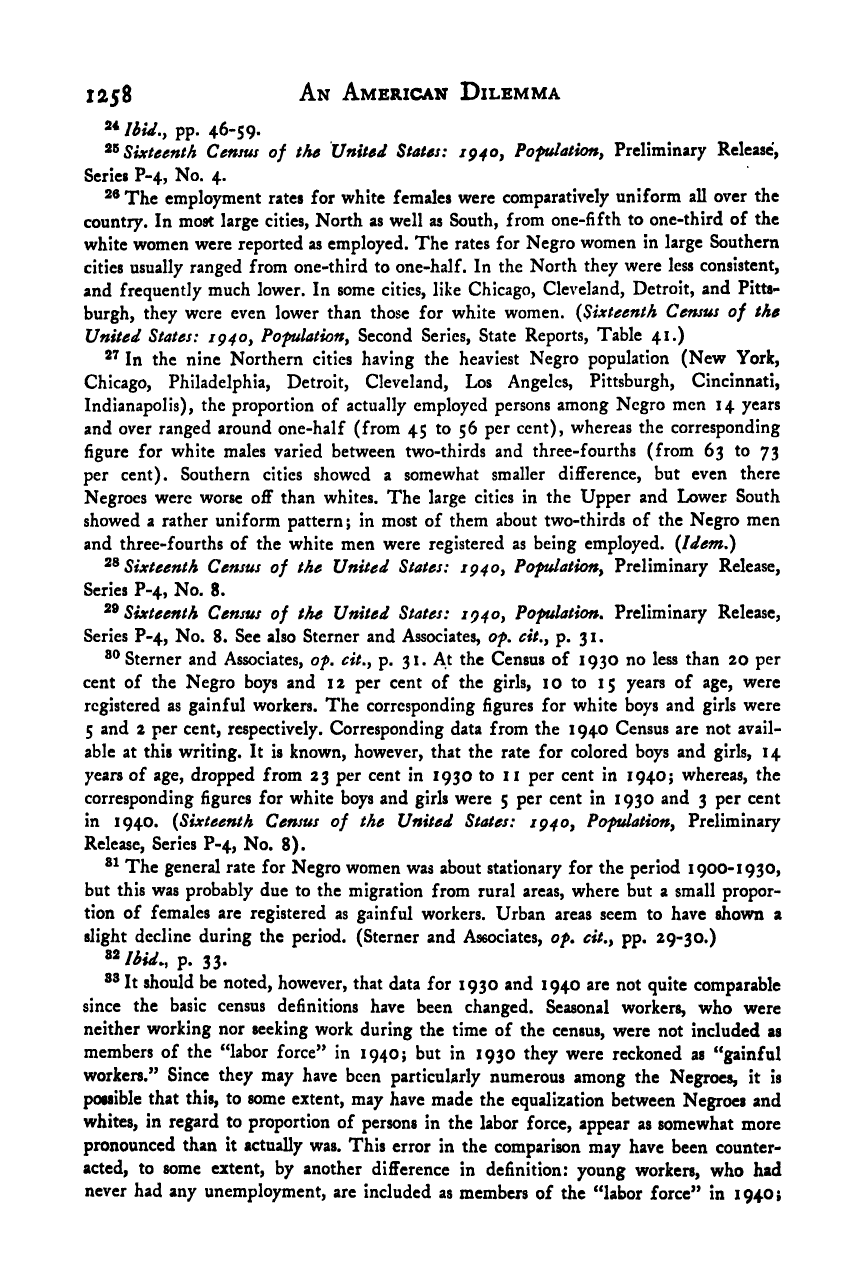Note: Gunnar Myrdal died in 1987, less than 70 years ago. Therefore, this work is protected by copyright, restricting your legal rights to reproduce it. However, you are welcome to view it on screen, as you do now. Read more about copyright.
Full resolution (TIFF) - On this page / på denna sida - Footnotes - Chapter 13

<< prev. page << föreg. sida << >> nästa sida >> next page >>
Below is the raw OCR text
from the above scanned image.
Do you see an error? Proofread the page now!
Här nedan syns maskintolkade texten från faksimilbilden ovan.
Ser du något fel? Korrekturläs sidan nu!
This page has never been proofread. / Denna sida har aldrig korrekturlästs.
An American Dilemma
1258
Ibid., pp. 46-59.
^Sixteenth Census of the United States: 1940, Pofulation, Preliminary Release,
Series P-4, No. 4.
The employment rates for white females were comparatively uniform all over the
country. In most large cities, North as well as South, from one-fifth to one-third of the
white women were reported as employed. The rates for Negro women in large Southern
cities usually ranged from one-third to one-half. In the North they were less consistent,
and frequently much lower. In some cities, like Chicago, Cleveland, Detroit, and Pitts-
burgh, they were even lower than those for white women. {Sixteenth Census of the
United States: ig40y Pofulationy Second Series, State Reports, Table 41.)
In the nine Northern cities having the heaviest Negro population (New York,
Chicago, Philadelphia, Detroit, Cleveland, Los Angeles, Pittsburgh, Cincinnati,
Indianapolis), the proportion of actually employed persons among Negro men 14 years
and over ranged around one-half (from 45 to 56 per cent), whereas the corresponding
figure for white males varied between two-thirds and three-fourths (from 63 to 73
per cent). Southern cities showed a somewhat smaller difference, but even there
Negroes were worse off than whites. The large cities in the Upper and Lower South
showed a rather uniform pattern; in most of them about two-thirds of the Negro men
and three-fourths of the white men were registered as being employed. {Idem,)
Sixteenth Census of the United States: ig40y Pofulationy Preliminary Release,
Series P-4, No. 8.
Sixteenth Census of the United States: ig40y Pofulation, Preliminary Release,
Series P-4, No. 8. See also Sterner and Associates, of, cit,y p. 31.
Sterner and Associates, of, cit,y p. 31. At the Census of 1930 no less than 20 per
cent of the Negro boys and 12 per cent of the girls, 10 to 15 years of age, were
registered as gainful workers. The corresponding figures for white boys and girls were
5 and 2 per cent, respectively. Corresponding data from the 1940 Census are not avail-
able at this writing. It is known, however, that the rate for colored boys and girls, 14
years of age, dropped from 23 per cent in 1930 to ii per cent in 1940; whereas, the
corresponding figures for white boys and girls were 5 per cent in 1930 and 3 per cent
in 1940. {Sixteenth Census of the United States: ig40y Pofulationy Preliminary
Release, Series P-4, No. 8).
The general rate for Negro women was about stationary for the period 1900-1930,
but this was probably due to the migration from rural areas, where but a small propor-
tion of females are registered as gainful workers. Urban areas seem to have shown a
slight decline during the period. (Sterner and Associates, of, cit,, pp. 29-30.)
^^Ihid., p. 33.
It should be noted, however, that data for 1930 and 1940 are not quite comparable
since the basic census definitions have been changed. Seasonal workers, who were
neither working nor seeking work during the time of the census, were not included as
members of the “labor force” in 194O; but in 1 930 they were reckoned as “gainful
workers.” Since they may have been particularly numerous among the Negroes, it is
possible that this, to some extent, may have made the equalization between Negroes and
whites, in regard to proportion of persons in the labor force, appear as somewhat more
pronounced than it actually was. This error in the comparison may have been counter-
acted, to some extent, by another difference in definition: young workers, who had
never had any unemployment, are included as members of the “labor force” in 1940;
<< prev. page << föreg. sida << >> nästa sida >> next page >>